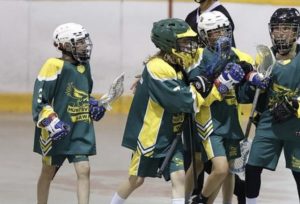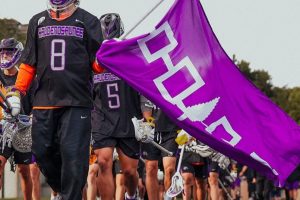Over the last three years, Muskoka has slowly transformed into Banditland North. And who’s responsible? Meet Steve Priolo, captain of the National Lacrosse League’s (NLL) Buffalo Bandits.
This Canadian athlete carries an impressive 15-year career. Just last year, he was named St. Catharines Athlete of the Year, captured the Canadian Lacrosse Association (CLA) Mann Cup for the second time, won World Champion gold with Team Canada for the third time, and led the Bandits to another NLL Champion Cup for a second consecutive year.
Then, On May 24, 2025, the Bandits once again hoisted the NLL Champion Trophy for the third year in a row. You can almost hear the chants now:
“Three-peat! Three-peat! Three-peat!”

On August 20, 2025, Priolo brought the coveted NLL Champion Cup to Canvas Brewing Co. in Huntsville, ON, for photos, autographs, and celebrations—a gesture of gratitude toward the fans and the community he’s been part of since moving to Huntsville in 2021.
“The Huntsville Hawks did such a great job welcoming me and involving me in their community,” Priolo said. “Each season I try to find a way to give back—for everything they’re doing for lacrosse. And in this case, at least for the last three years, it’s involved bringing the trophy home!”
He also recognizes the legacy of the Huntsville District Minor Lacrosse Association, which has been active for 60 years and is home to the local Hawks.
“Even in my short time here I’ve seen the sport of lacrosse grow exponentially- this shows a lot of community involvement and when I meet the kids and parents you can see the passion that they have for the sport. You’re seeing multiple teams per age group, the Hawks entering higher divisions and finding success at the bigger tournaments.”
During the event, speaker John Dinner, who has been instrumental in developing minor lacrosse at Rosseau Lake College (RLC), and forging partnerships with initiatives like the Haudenosaunee Sports Development Group and the Strong Roots Charitable Foundation, highlighted that the Huntsville Hawks have been able to compete in higher divisions because players are building connections, growing together, and strengthening teams through shared passions and experiences—and, most importantly, because parents are choosing to put lacrosse sticks in the hands of their children.

Steve Priolo himself is part of the RLC faculty, teaching Outdoor Recreation and Construction, while also actively coaching local teams.
“I’ve helped mostly with the U13s, U11s, and U9s,” he says. “It’s been sporadic as I am still playing, but through connections to my nephew’s team and friends’ kids’ teams, I try to get out when I can.”
When asked why he continues to balance RLC with his lacrosse career, Priolo explains,
“You spend your life trying to better yourself and gain knowledge, and I have a passion for passing on what I’ve learned. Whether it’s lacrosse or coaching other sports, it led me to a teaching profession.” He adds,
“It’s important to get involved with these younger generations because I want to leave the sport in a better place than I had it.”
Muskoka is home to many NLL fans, including supporters of the Toronto Rock. On Priolo’s podcast, Dinner with the Captain, co-hosted by John Dinner, he mentions how he enjoys the friendly rivalry between fans because it means there are more eyes and ears on the sport.
Canada has several NLL teams: Calgary Roughnecks, Saskatchewan Rush, Vancouver Warriors, Toronto Rock, and the newly added Ottawa Black Bears.

When focusing on Minor Lacrosse Leagues, however, there are hundreds of teams across the province.
Each August, the Ontario Lacrosse Festival (OLF) in Durham Region hosts one of the largest youth lacrosse events in Canada—and possibly the largest in the world.
According to the Ontario Lacrosse Association, the OLF attracts approximately 447 teams and around 8,000 athletes and coaches annually. The festival spans ten days, features 34 provincial championships across various age groups, and draws an estimated 50,000 spectators over its duration.
So what makes lacrosse special?
Priolo has always been a huge supporter of playing multiple sports and expanding your athletic realm. Which fits perfectly with lacrosse, since its very dynamic—it combines elements from basketball, like footwork, the physicality of hockey, and other aspects of athleticism such as speed and endurance. In Priolo’s words told to BPSN, “That’s what makes it beautiful.”
His versatility and dedication propelled him through his career. Priolo explains on his podcast, that he naturally latched onto incredible mentors and always sought to learn from the best in the sport. This allowed him to refine his skills and later focus on building a team with like-minded people, keeping the team moving as one unit. As he puts it, “Avoiding the cliques” and accepting “personalities” to make the team whole.
Besides the physical skill and enjoyment many players get from lacrosse, there is also a sense of patriotic pride associated with the sport.
After all, it is Canada’s national sport.
Wait, what about hockey? Well, hold on there, bud…
Lacrosse was declared Canada’s national sport first in 1869, long before hockey gained widespread prominence. Then, in 1994, the National Sports of Canada Act was passed, officially designating lacrosse as Canada’s national summer sport and ice hockey as the national winter sport.
You see, to truly appreciate lacrosse we need to go back further — much further, to around 1100 A.D., making it one of North America’s oldest organized team sports. Among the Haudenosaunee people, lacrosse is known as Tewaarathon, meaning — “little brother of war” — and is often referred to as “the Creator’s game” or “the Medicine game.”
In 2021, Jeremy Thompson a lacrosse player of the Onondaga Nation explained it best in an educational video titled Roots: Exploring the History of Lacrosse:

“The Haudenosaunee people were first given this game over a thousand years ago as a gift from the Creator.
It was given to us as a medicine game. A ceremonial game was called to heal the sick and make peace among nations and to have fun.”
Sometimes these games would include hundreds of players, playing on a field close to 3 kilometers long, according to The Lacrosse Network.
Thompson continues:
“We had no referees, it was a ceremonial game played with a wooden stick made from the hickory tree. Representing all plant life. The net was made from the sinew of the deer. Representing all animals. The wooden stick represented our connection to the natural world. This game connects us to the earth. A stick is put in our cradle board when we are born and we are buried with our stick when we die. We will carry our stick in the next world to play with our ancestors who are waiting for us. When we play competitive lacrosse, we carry the values of the medicine game onto the field and into the box. We are the originators of this game. It is our way of life for our people. It is a great honour to be a lacrosse player.”
As settlers began to arrive in Canada, they soon gravitated to the game.
“In 1630s the french missionaries coined the name “la crosse” because they thought the stick looked like the crozier or the cross the bishops carried. They also changed the Haudenosaunee name to the “Iroquois” and the game began to take a new shape,” he says. “In Montreal, Canada, lacrosse was played for the first time outside of a native reservation. Then 200 years later Canada declared lacrosse as its national sport. In doing so, they distanced lacrosse from its native roots and intentions.”
Canadians of the Victorian era took what was not theirs and claimed it as their own — a past now brought to light to ensure it never happens again.
In the views of the Iroquois, the game was “A gift from our people to share with the world.”
Thompson also quotes Oren Lyons, a former All-American goalkeeper at Syracuse, Lacrosse Hall of Famer, Onondaga faithkeeper, and global speaker:
“When you talk about lacrosse you talk about the lifeblood of our six nations; The Mohawk, Oneida, Onondaga, Cayuga, Seneca, and Tuscarora Nations.”
He finished the video by saying:
“It is my family’s and my people’s hope that lacrosse will be welcomed by everyone. That the game will be played with honour. We hope that lacrosse will bring a world community based on true friendship, respect and peace. We hope that lacrosse and the Iroquois nationals will be in the Olympics in 2028.”
The movement to ‘Grow the Sport’ has been gaining momentum since the 2000s. Steve Priolo and many other players are helping lacrosse gain traction by continuing to push the game towards larger stages. In October 2023, the International Olympic Committee (IOC) approved the inclusion of lacrosse in the 2028 Summer Olympics in Los Angeles — its first appearance as a medal sport in over a century.
This growth has also increased funding and sponsorships for lacrosse within communities across Canada. At Rosseau Lake College, for example, the school has received hundreds of donated lacrosse sticks by organizations such as Traditional Lacrosse, the Haudenosaunee Sports Development Group, and the Strong Roots Charitable Foundation based in Akwesasne.
These efforts have also expanded media coverage, allowing more people to experience the sport through broadcasts on TSN and ESPN, as well as through podcasts and digital content like Dinner with the Captain, The Back of the Bird, and The Creators Game Podcast.

From youth programs at Rosseau Lake College to local leagues in Muskoka and major NLL games, lacrosse continues to fight for the spotlight thanks to dedicated athletes like Steve Priolo.
For those who want to keep their eyes and ears on the sport, Priolo is currently playing for the Six Nations Chiefs in the Major Series Lacrosse (MSL) league during the summer season. Let’s cheer them on as they enter the Ontario finals, hoping to make another push for the Mann Cup trophy!








